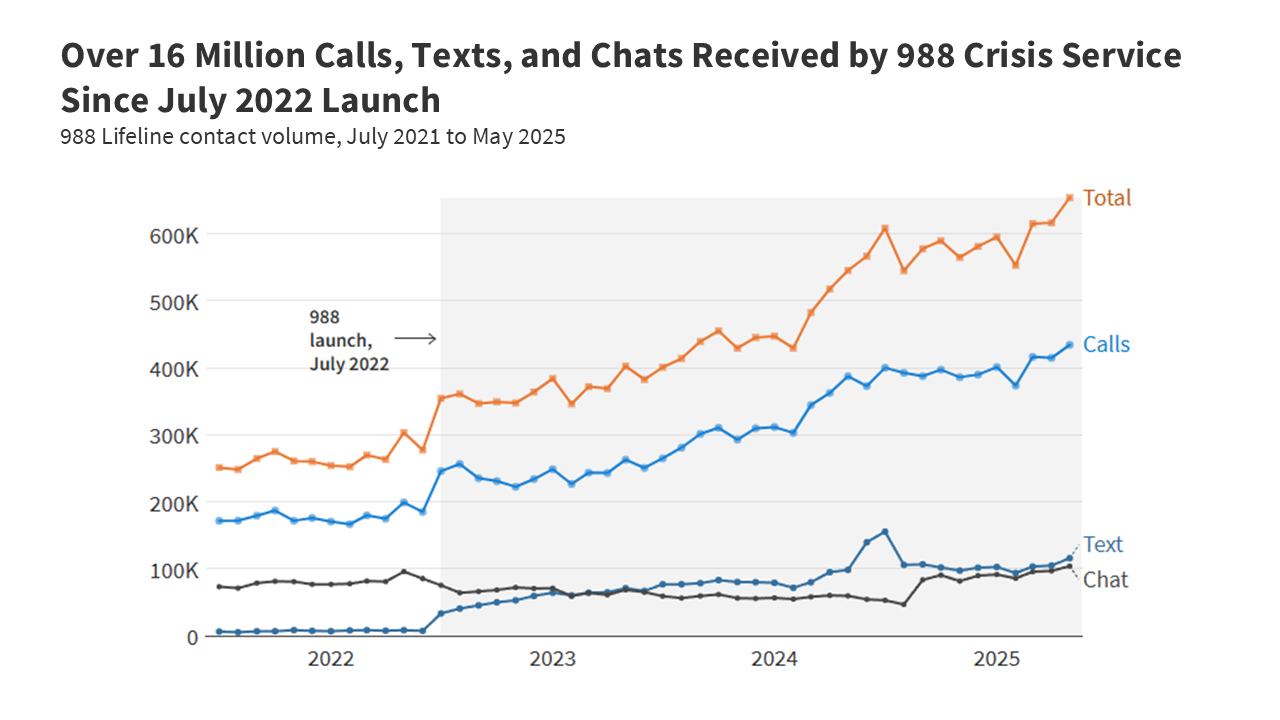On July 16, 2022, the federally mandated crisis number, 988, became available to all phone users at no charge. This three-digit number connects users–via phone, text, or chat–to a network of over 200 local and state-funded crisis call centers that provide access to crisis counseling, resources, and referrals through the 988 Suicide & Crisis Lifeline. The introduction of 988 came against the backdrop of rising suicide rates. Between 2013 and 2023, more than half a million lives (509,115) were lost to suicide, with increases observed nationally and across most states. Firearms have been the predominant suicide method, accounting for over half of all suicide deaths and contributing to a record high number of suicides in 2022.
988 enters its third year amid significant legislative changes to Medicaid and other health programs, projected by the CBO to reduce federal Medicaid spending by $1 trillion dollars and result in 11.8 million people losing health coverage (from Medicaid and Marketplace changes) over the next 10 years. These changes could disrupt access to mental health care and create ripple effects across the broader mental health system. The HHS budget has proposed maintaining current 988 funding levels, much of which supports 988’s federal infrastructure. At the same time, the substantial federal Medicaid spending reductions in the recently-passed 2025 tax cuts and domestic policy bill could lead states to scale back spending, including on behavioral health services. The recent elimination of the specialized 988 service for LGBTQ+ young people—which previously handled about 10% of all 988 contacts—raises concerns about the mental health support for LGBTQ+ youth, a population already experiencing high rates of suicidal ideation and attempt.
Taken together, these changes could simultaneously increase mental health needs and reduce available support, potentially leading to higher rates of suicide attempts or deaths in coming years. This policy watch examines 988 on its third anniversary, drawing from the latest Lifeline data available through May 2025 and suicide death data from CDC WONDER for the period 2013 to 2023.
988 received 16.5 million contacts since its launch in July 2022, including 11.1 million calls, 2.9 million texts, and 2.4 million chats. Monthly contact volume has steadily increased, consistently surpassing 500,000 contacts per month over the past year and approaching or exceeding 600,000 per month since early 2025—double the contacts recorded before launch (303,332 in May 2022). Public awareness of the 988 service was low in 2023 but may have since improved, potentially contributing to the increases in contact volume. These 988 metrics do not include suicide hotline contacts from centers operating outside of the 988 network. As of 2022, fewer than half of all hotline call centers (about 200 of 544) participated in the 988 network.
Most states now answer 80% or more of 988 calls in-state, a significant improvement compared to before 988’s launch. In May 2025, 42 states answered at least 80% of calls locally, up from 23 states just before 988’s launch. In-state answer rates in May 2025 ranged from 58% (Arkansas) to 99% (Rhode Island). Calls not answered in-state are redirected to national backup centers, where counselors answer the crisis call but may be less familiar with local resources. Nationally, 91% of 988 calls, texts, and chats are answered, while 9% are disconnected—for reasons that may include the person ending the contact or technical issues. This compares to a 30% disconnection rate before 988’s launch in May 2022. Federal funds supported 988’s launch, including some initial funding to support state infrastructure and local call centers, but ongoing funding for these call centers largely falls to states. Currently, 12 states passed legislation to help fund 988 through telecom fees (similar to 911 funding), with early-adopting states raising between $8 and $44.3 million in CY2023. Several other states have appropriated funds for 988, related crisis services, or efforts to improve interoperability across crisis response systems—and Medicaid, along with other payers in some cases, may also help finance 988 and related crisis services.
The overall number of suicide deaths remained stable from 2022 to 2023 (49,476 to 49,316), though it is too soon to fully determine the impact of 988. This stability was driven by small declines in non-firearm (other) suicides, while firearm suicides increased slightly (Figure 3). These patterns were generally consistent across demographic groups, including several of those previously experiencing increases over longer periods. Provisional CDC data suggest this stabilization may be continuing into 2024 (48,796), though these data are preliminary and may be incomplete. While there is no direct way to measure the effect of 988 on these rates, it could be a factor.
If you or someone you know is considering suicide, call or text the 988 Suicide & Crisis Lifeline at 988
Publisher: Source link









